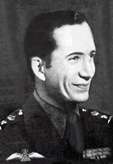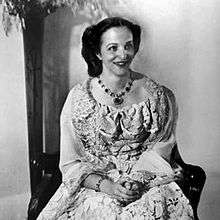Ghazi of Iraq
| Ghazi I of Iraq | |||||
|---|---|---|---|---|---|
 | |||||
| King of Iraq | |||||
| Reign | 8 September 1933 – 4 April 1939 | ||||
| Predecessor | Faisal I | ||||
| Successor | Faisal II | ||||
| Born |
2 May 1912 Mecca, Emirate of Mecca, Ottoman Empire | ||||
| Died |
4 April 1939 (aged 26) Baghdad, Kingdom of Iraq | ||||
| Burial | Royal Mausoleum, Adhamiyah[1] | ||||
| Spouse | Princess Aliya bin Ali | ||||
| Issue | Faisal II | ||||
| |||||
| House | Hashemite | ||||
| Dynasty | Hashemites of Iraq | ||||
| Father | Faisal I | ||||
| Mother | Huzaima bint Nasser | ||||
| Religion | Sunni Islam[2] | ||||
Ghazi bin Faisal (Arabic: غازي ابن فيصل Ġāzī bin Fayṣal) (2 May 1912 – 4 April 1939) was the King of the Hashemite Kingdom of Iraq from 1933 to 1939 having been briefly Crown Prince of the Kingdom of Syria in 1920. He was born in Mecca, the only son of Faisal I,[3] the first King of Iraq.
Early life
Ghazi was the only son of Faisal (later to become King Faisal I of Iraq) and Huzaima bint Nasser. In his childhood Ghazi was left with his grandfather, Hussein bin Ali, the Hashemite Grand Sharif of Mecca and head of the royal house of Hashim, while his father was occupied with travel and in military campaigns against the Ottomans. The Hashemites had ruled the Hijaz within the Ottoman Empire before rebelling with British assistance in the later stages of World War I. He attended Harrow School.
Unlike his worldly father, Ghazi grew up a shy and inexperienced young man. Following the defeat of his grandfather's army by Saudi forces in 1924, he was forced to leave the Hijaz with the rest of the Hashemites. They travelled to Transjordan where Ghazi's uncle Abdullah was King. In the same year, Ghazi joined his father in Baghdad and was appointed as crown prince and heir to the Kingdom of Iraq. His father had been crowned following a national referendum in 1921.
Flying Carpet
| Wikimedia Commons has media related to Ghazi of Iraq. |
As a 16-year-old schoolboy, he met the traveller-adventurer Richard Halliburton and his pilot Moye Stephens during their round-the-world flight (shortly after Charles Lindbergh's celebrated transatlantic flight). Ghazi was taken for his first flight by Halliburton and Stephens in a biplane named the 'Flying Carpet'. They flew down to see the ruins of Ancient Babylon and other historical sites and flew low over the prince's own school so that his schoolmates could see him in the biplane. An account of young prince Ghazi's experience flying over his country can be found in Richard Halliburton's The Flying Carpet.[4]
Simele Massacre
Ghazi came to Simele to award 'victorious' colours to the military and tribal leaders who, on 11 August 1933, participated in the Simele massacre of Assyrians and the looting of their homes.[5]
King of Iraq
On 8 September 1933, King Faisal I died, and Ghazi was crowned as King Ghazi I. On the same day, Ghazi was appointed Admiral of the Fleet in the Royal Iraqi Navy, Field Marshal of the Royal Iraq Army, and Marshal of the Royal Iraqi Air Force. A staunch pan-Arab nationalist, opposed to British interests in his country,[6] Ghazi's reign was characterized by tensions between civilians and the army, which sought control of the government. He supported General Bakr Sidqi in his coup, which replaced the civilian government with a military one. This was the first coup d'état to take place in the modern Arab world. He was rumoured to harbour sympathies for Nazi Germany and also put forth a claim for Kuwait to be annexed to Iraq. For this purpose he had his own radio station in al-Zuhoor royal palace in which he promoted that claim and other radical views.[7]
Death
Ghazi died in 1939 in an accident involving a sports car that he was driving.[7] According to the scholars Ma'ruf al-Rusafi and Safa Khulusi, a common view by many Iraqis at the time was that he was killed on the orders of Nuri al-Said, because of his plans for unification of Iraq with Kuwait.[8]
Faisal, Ghazi's only son, succeeded him as King Faisal II. Because Faisal was underage, Prince Abdul Ilah served as regent until 1953.
Marriage and children

On 25 January 1934 Ghazi married his first cousin, Princess Aliya bint Ali, daughter of his uncle King Ali of Hejaz in Baghdad, Iraq. They had only one son:[3]
- Faisal II, King of Iraq – born 2 May 1935, died 14 July 1958.
Ghazi was suspected of having an extra-marital affair with a young Iraqi servant. British sources wrote in 1938 that King Ghazi’s bad reputation was tarnished “further” when a “Negro youth,” who was employed at the palace, died by “accidentally” discharging his revolver when he didn’t remove it before his afternoon siesta. An official police expert ruled that the Palace's explanation was consistent with the police examination.[9]
But the British suspected there was more to the story, in particular that one of Queen Aliya’s “adherents” might have killed the boy, as the boy was suspected to be “the King’s boon companion in debauchery” and the Queen therefore had a “deep aversion” to the boy. The King was in a panic after this incident, fearing imminent assassination.[9]
Ancestry
See also
References
- ↑ Royal Ark Retrieved 2017-11-24.
- ↑ "IRAQ – Resurgence in the Shiite World – Part 8 – Jordan & The Hashemite Factors". APS Diplomat Redrawing the Islamic Map. 2005.
- 1 2 "The Hashemite Royal Family". Jordanian Government.
- ↑ "Richard Halliburton and Moye Stephens: Traveling Around the World in the 'Flying Carpet'". Historynet. 2006-06-12. Retrieved 2017-11-24.
- ↑ Stafford 2006, p. 188
- ↑ Tripp, Charles. A History of Iraq. Cambridge University Press: Cambridge, 2000, p.81.
- 1 2 Tripp, p.98.
- ↑ Safa Khulusi, Ma'ruf Al-Rusafi (1875–1945). The Muslim World, Hartford Seminary Foundation, LXVII No.1, 1977.
- 1 2 "The National Archives of the UK, "1938, FO 406/76, telegram no. 31"". Drewhkinney.com, in "Data". 1938. Archived from the original on 2017. Retrieved 2017-11-24.
- ↑ Kamal Salibi (15 December 1998). The Modern History of Jordan. I.B.Tauris. Retrieved 7 February 2018.
- ↑ "Family tree". alhussein.gov. 1 January 2014. Retrieved 8 February 2018.
- Ali, Tariq. Bush in Babylon: the Recolonisation of Iraq. W.W. Norton, 2003. ISBN 1-85984-583-5.
- Stafford, R (2006) [1935]. The Tragedy of the Assyrians. Gorgias Press LLC. ISBN 978-1-59333-413-0.
External links
- "Young King". Time Magazine. 17 April 1939. Retrieved 17 August 2009.
- "Coins of Ghazi I." Retrieved 30 August 2009.
- Newspaper clippings about Ghazi of Iraq in the 20th Century Press Archives of the German National Library of Economics (ZBW)
o
Ghazi of Iraq Born: 12 March 1910 Died: April 4 1939 | ||
| Regnal titles | ||
|---|---|---|
| Preceded by King Faisal I |
King of Iraq 8 September 1933 – 4 April 1939 |
Succeeded by King Faisal II |
| Titles in pretence | ||
| Preceded by King Faisal I |
— TITULAR — King of Syria 8 September 1933 – 4 April 1939 Reason for succession failure: Kingdom abolished in 1920 |
Succeeded by King Faisal II |
